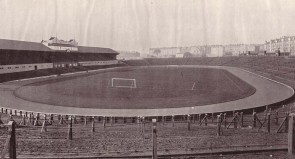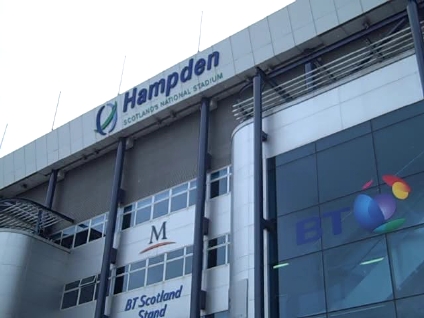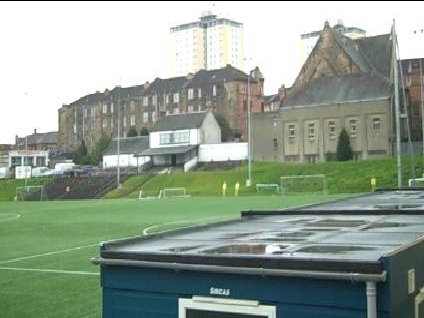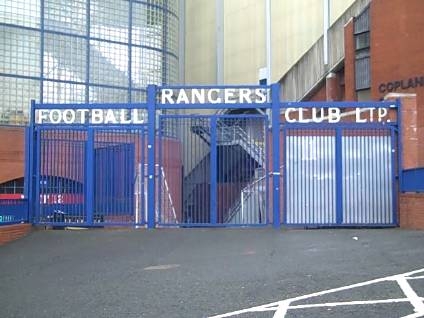Glasgow is a happy playground for the historically-aware football fan.
It was, therefore, with great excitement that I headed north from Euston for Arsenal’s Champions League qualifier with Celtic. The match that evening was a great excuse to come to somewhere I’d never been, but I was also hoping to spend a few hours exploring a few sights I’d long dreamed of seeing.
Mount Florida station is in a well-to-so suburb south of the Clyde, but has been for generations a step on the march to Hampden Park. Scotland’s national stadium may have been hosting a U2 concert that night, but I had different reasons for visiting. For many years Hampden was the largest football stadium in the world, a place where gates of 100,000 weren’t just the norm, they were considered disappointing. The ground crammed in 149,415 for a Scotland vs England match in 1937, but as late as 1970 it 136,505 piled onto Hampden’s mighty terraces for a Celtic Vs Leeds United European Cup Semi-Final. Together with then-mammoth Ibrox Park and Celtic’s Parkhead, Glasgow could in 1920 boast three stadiums capable of holding 90,000 spectators. No other city in the world has ever been able to make this claim. It happened at Hampden first: turnstiles, a press box and all-ticket matches.

Hampden Park in 1922

Hampden Park today
These days Hampden holds a more modest 52, 103 and has long been all-seater. Outside it’s mighty walls sit the offices of Queens Park FC, a titan of Scottish football history. The Spiders, who basically invented football in Scotland and taught the English how to play their own game, remain the only truly amateur side playing senior football anywhere in Europe. They may languish today in the Third Division and scrap away in front of a few hundred fans, but Hampden is still where their home fixtures are played. In 1930 they hosted Rangers, the match attracting 95,722. Elsewhere in that first round of the Scottish Cup a mere 150 pitched up to see Civil Service South vs Clachnacuddin, generating the mighty sum of four pounds at the gate.
Queens Park’s offices were open and after having picked up a shirt and other QPFC goodies I was led into the depths of their prefabricated huts onto the all-weather training pitch at Lesser Hampden where their reserves and Junior sides play. Standing sentinel over this pitch is what is believed to be the world’s oldest football stand. This converted farmhouse has a double life as a pavilion and minibus park and dates back to the early nineteenth century. Sadly this is what remains of old Hampden: the giant banks of terracing are a thing of the past.

The world's oldest football stand at Lesser Hampden
I didn’t have to wait long to find some terraces. A short walk away is unassuming Cathkin Park, the sort of place where men walk dogs in mid-afternoon. Cathkin has two reasons for significance. It was the site of an earlier Hampden Park, and on Queens vacating it’s genteel slopes for today’s site was taken over by Third Lanark FC. One of the mythical names of Scottish football, Thirds were three times League Champions and twice Scottish FA Cup winners. The good times infamously did not last: the Hi Hi (a nickname coming from the club’s best known chant) were wound up in April 1967 amid shady business practices.
I shot some video at Cathkin Park.
From here I took the train back into Glasgow Central, and walked up to Buchanan Street for a ride on the ‘Clockwork Orange’, as Glasgow’s underground railway is known. The service is the world’s third oldest subway and took me in around fifteen minutes to Ibrox Park, home of Glasgow Rangers. This stadium too is much changed from its original oval shape, and would be an unremarkable if imposing modern stadium if not for one thing. The Bill Struth Main Stand, recently renamed after their legendary manager, is the crowning glory of Archibald Leitch’s huge contribution to British football stadium architecture. Immense in form and ambition and richly symbolic of Ranger’s pre-eminence across Glasgow and the Scottish game in the 1930s, it is also the only rival I have seen to Arsenal’s East Stand. After pushing open an ornate door and hanging around after looking slightly lost for a while a friendly receptionist took me out to see the pitch. It was interesting also to note that Paul Gascoigne is one of the few names inscribed on the Rangers Hall of Fame board Back outside, Ibrox is not the most charming of neighbourhoods, so it was back onthe train into town.

Ibrox Park

Celtic Park
Evening brought a stroll up Gallowgate past countless Celtic bars, several of which had bands in full swing three hours before kick-off. Celtic Park, or Parkhead after the East End district it is found in felt reminiscent of Old Trafford from the outside and in. The match has been covered elsewhere, but after a lot of noise from our hosts – and a lot of fun in the away end – it was back to Glasgow Central and on to the sleeper to Euston. There is much still to see in Glasgow. I didn’t make it to Firhill, home of Partick Thistle. Bono’s arrival put the bosh on visiting the Scottish Football Museum and touring Hampden. Nor did I do any of the traditional must-sees in Glasgow. A return visit is in order: Rangers must deliver in the Champions League.
For more on Glasgow try here.

Pingback: Travel highlights of 2009 « Tom Hall: London & Overseas Travel